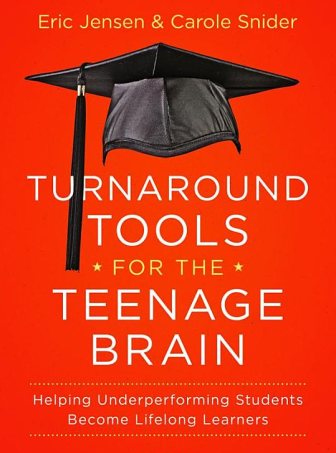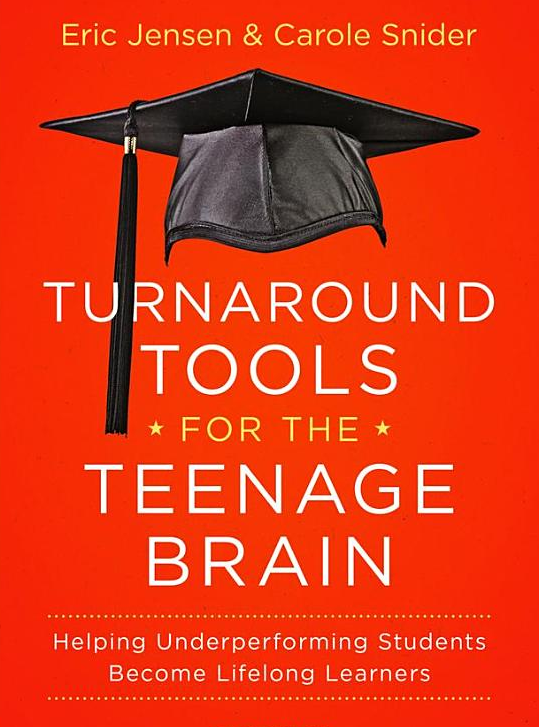 Turnaround Tools for the Teenage Brain: Helping Underperforming Students Become Lifelong Learners
Turnaround Tools for the Teenage Brain: Helping Underperforming Students Become Lifelong Learners
Eric Jensen and Carole Snider
Jossey-Bass, 2013
164 pages
By Jami Jones
It is the beginning of a new school year. For a fortunate few, learning seems effortless.
Some students understand that focused, hard work matters and that having a dedicated work space with no distractions, managing time, completing homework, and coming to class prepared and on time are important to their success. They can count on this year being much like others —successful. A second group of teens can expect more of the same, too: frustration and lost opportunities for learning that continue to widen the achievement gap between them and their higher-performing peers. These students (and the adults who need to support them) may not realize that by applying specific success strategies and some interventions, they could become higher performers, too. Eric Jensen and Carole Snider’s book is written to support this latter group of struggling and underperforming teens who inch closer to disengagement with each passing year.
Jensen and Snider tackle a most significant educational issue — student drop-out rates — by describing the turnaround tools “to create a mind-set in your students that life is not a race. It’s all about putting pieces in place that empower you to become your best self.”
“Turnaround Tools for the Teenage Brain” is a research-based book that cogently presents the background knowledge, strategies and skills to transform the too-often used “all children can learn” message into reality. Although the book’s primary audience is educators, anyone who works with teens, or their parents, and wants to ensure their success, will find this book meaningful and helpful.
“Turnaround Tools” is organized into eight chapters, leading readers to understand that students’ underperformance is not destiny: Brains are malleable, and “if you have the will and skill, you can make a significant and lasting difference in more students’ lives than you ever thought possible.” Chapters address important topics such as learning for life, building cognitive capacity, fostering student effort, and strengthening body, mind and soul.
Readers are positioned to teach and model the useful strategies identified in this book when they know and understand their students’ strengths and challenges. Only then can change occur. Building cognitive capacity to learn — the authors refer call this “upgrading” the brain — trumps content. Teaching is likely wasted time when students lack important skills to absorb and process academic information.
Each chapter includes “What You Can Do” text boxes that translate research findings from neuroscience, psychology and education into specific practices to help upgrade a teen’s brain. Jensen and Snider describe learning strategies that research proves are most effective, such as feedback, reinforcement of learning, reciprocal teaching by having students teach a newly acquired concept and study and thinking skills.
Sprinkled throughout this book are stories about underperforming students who might have remained that way if it had not been for teachers who intervened to apply these effective learning strategies. Jensen describes his own schooling to illustrate the “mother lode” learning strategy: helping students to develop high expectations for themselves through challenging assignments that require synthesis and analysis and providing feedback to improve performance. He describes his own experience as a “train wreck” that turned around after two secondary teachers reached out to him and “kept their expectations high while establishing a positive relationship.” Since those train-wreck days, Jensen’s successes include authoring 26 books to improve learning for students and cofounding SuperCamp, a residential summer camp for teens that teaches the strategies identified in this book.
Snider has a story, too. She describes her son Gary’s toxic relationship with a teacher that accounted for a miserable fourth-grade year and the dreaded, but necessary, motivational pep talks just to get him to attend school. Thankfully, fifth grade turned around for Gary, who finally had a teacher who thought he was one of the neatest kids she had ever taught. Teacher-student relationships have a large effect, which is why relationships top the list of Jensen and Snider’s eight “nudges” for changing the teen brain. Without having positive relationships with students, it’s difficult to help them set high expectations. It seems there is empirical truth in the mantra: Students don’t care how much you know until they know how much you care.
The important take-away from this book is that educators, social workers, guidance counselors, youth workers, parents and anyone who works with and values teens can change their educational and life experiences and trajectories by changing their brains. In the United States we tend to adhere to the implicit theory that intelligence is fixed — that one’s intelligence quotient (IQ) cannot be improved. When students believe this myth, they are less likely to undertake challenging tasks or projects if making mistakes suggests a lack of intelligence. Teaching students that brains can change for the better impacts their effort, motivation and response to challenges by removing risks.
Jensen and Snider firmly assert that intelligence is malleable and can be developed. This is an especially hopeful message for children growing up in poverty whose heritability of parental IQ is below 10 percent. “In short,” Jensen and Snider write, “for kids who grow up in poverty, environmental factors are more likely than genes to adversely contribute to their basic intelligence as measured by IQ.”
This lucid research-based book is the perfect reading choice for educators, parents, and other professionals who work with teens who seem stuck in the mindset that they aren’t smart enough and that challenges often lead to risks they are unwilling to take. This book could put an end to the eye-rolling “it’s so boring” sentiment that struggling teens seem to make.


























